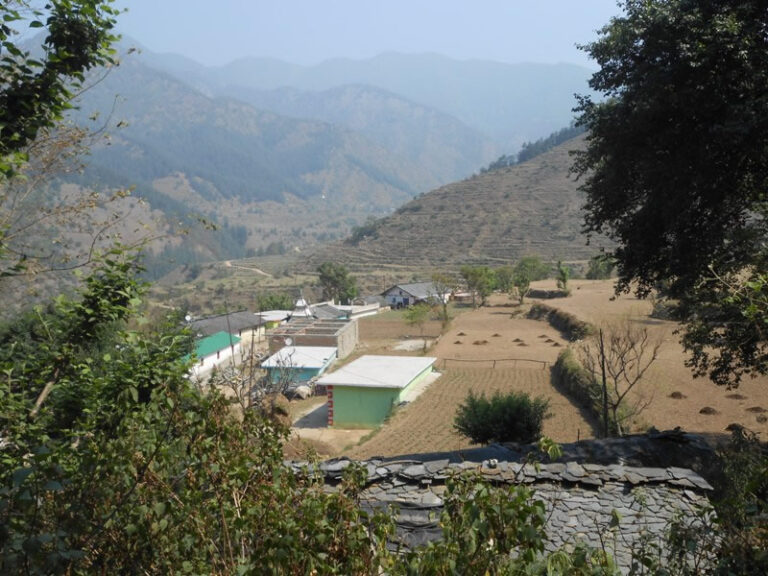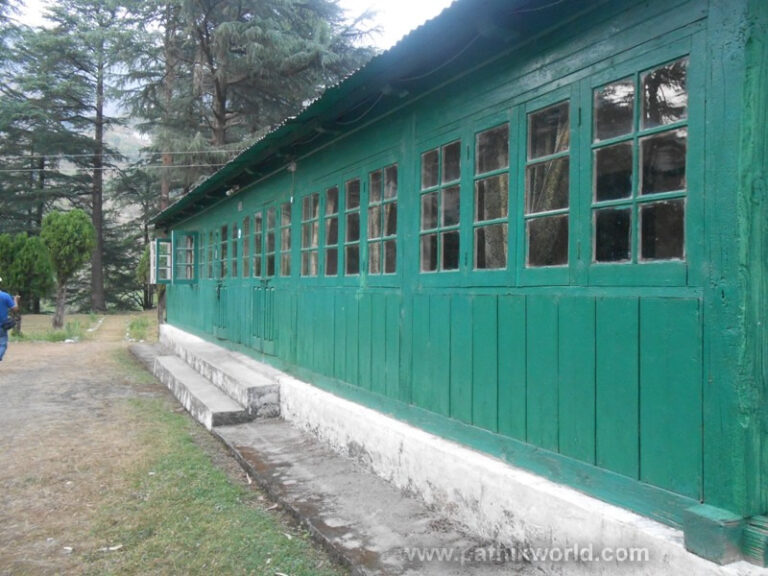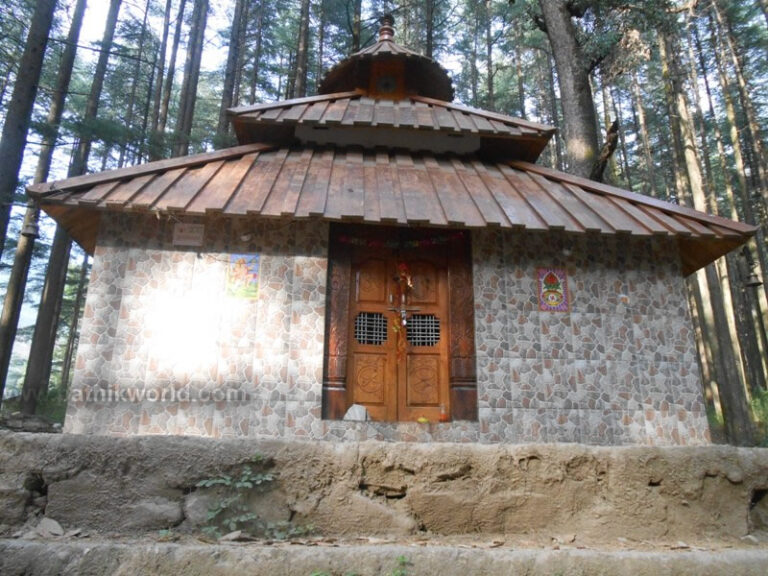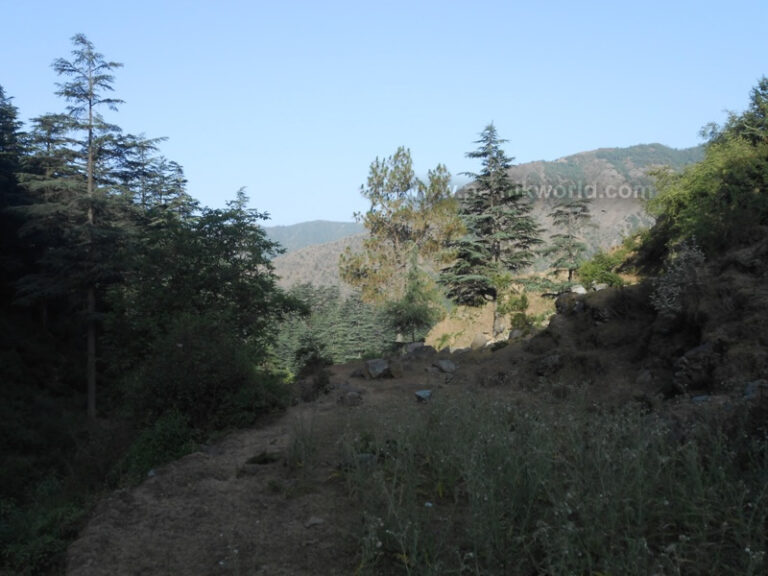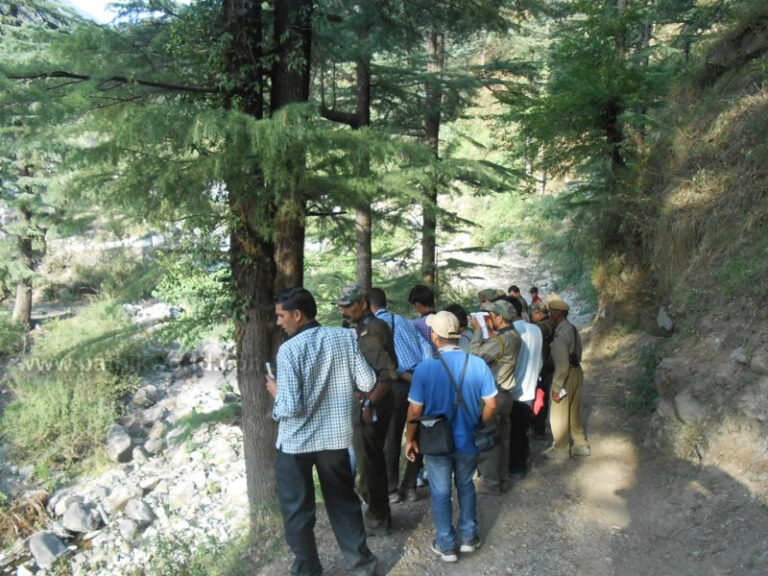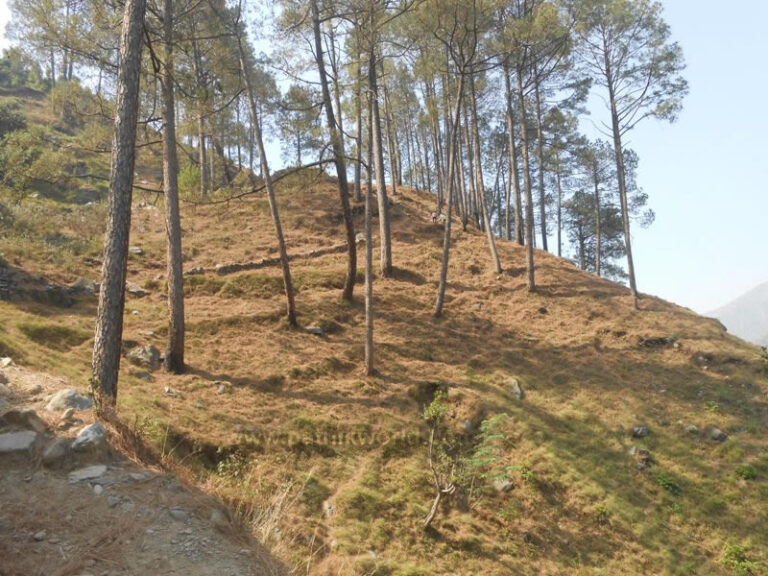In Garhwal, it is known as Deodar or Dev-daru. That is, the Tree-of-the-Gods, known to botanists as Cedrus deodara or the Himalayan Cedar. And indeed, if one visits the beautiful evergreen forest at Deolsari, one can see why. Vast, tall and stately stands of virgin old-growth deodar cloak the hillside, making for an unforgettable scene.
Deolsari is up a northern arm of the Aglar Valley. It is also the start of the trek to Nag Tibba – which at an altitude of 3,048 m. (9,996 ft.) the highest point on the ridge facing Mussoorie to the north, the Middle Himalaya or Mahabharat Range. This is the third parallel range of the Himalayas. Used in the fragrant and valuable Deodar timber, the forest has since been allowed to grow naturally. A small lord Shiva temple exists here, which has architecture unusual to Hindu temples, with a steeply pitched three-tiered pagoda-style roof. A Forest Rest House is almost adjacent and is bookable via the DFO Mussoorie while one Eco-Lodges are also there. As Deolsari is a hidden gem, many visitors to Deolsari have historically been from Mussoorie. Even when Mussoorie warms up before the rains, Deolsari remains cool despite being at a lower altitude since it is cosily positioned in a rich, ancient forest.
Deolsari is accessed via Thatyur in the Aglar Valley. Taking the Mussoorie- Tehri Road to Suakholi (the dhabas here produce adequate aloo-parathas), one must take a sharp left, descending past Magra into the Aglar Valley (both covered in separate chapter). Following this road as it winds softly downhill eventually leads to the small town of Thatyur. In the 1970s this was but a village, but Thatyur is now a bustling junction and market town (casbah) with all the modern ills of traffic jams and polythene bags. Thatyur is now good only for picking up some last-minute provisions, though there are seedy “emergency” lodgings on offer at a few dhabas.
The road that climbs up to Deolsari is right via the northern side of town, over the Aglar bridge. From here, the bustle of the town promptly gives way to terraced fields, scrubby hill forest and patches of Deodar cedar forest as the route follows the gorge of the Pail Gad stream uphill. The path is drivable in most cars, but a jeep or some other sturdy vehicle will be useful. This climb to Deolsari is itself a great time to begin briding.
The mix of terraced fields and natural vegetation attracts many birds. The Burberry (Berberis spp.) that fruits in April-June attracts fruit-eating birds. Stopping on the way, one may see Black Partridge, Hill Partridge, Himalayan Greenfinch, Rufous-gorgeted Flycatcher, whiskered Yuhina, Black Bulbul, Common Stonechat, Blue-throated Barbet, White-collared Blackbird, Blue-capped Redstart and Red-billed Leiothrix. The orange-and-yellow blooms of Blood Flower (Asclepias currasavica), will attract the spectacular Paris Peacock butterfly in the monsoon, creating a truly special memory. The last large village on the jeep track is Untar. Here, two crops a year are grown, thanks to perennial streams and – as the gorge is wider here – abundant sunshine. Just above is the roadhead of Bansil, where a chai break might be had. Parking here is safe but valuables should be removed. Plans to extend the jeep track to Deolsari have been wisely vetoed by the spectacular view of the pristine Deodar forests, which soften the harsh lines of the mountains as they climb steeply into the sky.
At Bansil, a concrete-lined path descends to the Pali Fad stream, crossing it via a concrete bridge. The path then climbs gently to Deolsari. The FRH, in a grassy glade in the furnished suites. Recently renovated and with a friendly staff, the FRH now boasts of an electricity connection. The temple and FRH (now both renovated) are just a hundred yards apart, if that. The compound has a tree nursery and garden. These are not the gardens of Versailles, but have have some charm. Tea and biscuits on the lawn, book in hand, will give satisfaction.
Oddly, this FRH is less visited than in, say, the 1970s, despite being more accessible and comfortable than ever. A week-long trek to Deolsari long was a rite of passage for students of the better-known boarding schools (i.e. the usual suspects) of Mussoorie and Dehradun. One may ask if the once-familiar breed of ‘hardy’ boarding school students has gone the way of Ophrysia superciliosa?
As for the temple, it is itself built with Deodar planks and masonry (Now renovated). It is windowless and the door is secured via masterious all-wooden lock. The hereditary priest is parked in a cosy salaried job in Dehradun and only comes up but twice a year, including on the local festival day, to lead the prayer and benediction ceremonies.
While single-species Deodar forest is itself not always the best for birding, the surrounding areas are worth exploring. The local patches of mixed Oak-Rhododendron and Burberry bushes attract many birds. One may seek Himalayan Woodpecker, Rufous-bellied Woodpecker, Bar-tailed Treecreeper, White-throated Laughingthrush, Mountain Bulbul, Chestnut-headed Tesia, Yellow-breasted Greenfinch, Red-headed Bullfinch and Pink-browed Rosefinch. It is imprudent to walk outside the FRH compound after dark, as there are chances of encountering the unpredictable Himalayan Black Bear. But one may walk the periphery with a torch. Grey Nightjar, the calls of which are heard frequently after dark, may be seen. There are also Spot-bellied Eagle Owl and Asian Barred Owlet here. With good fortune, one may come across Yellow-throated Marten, a weasel-like animal that roams at night and occasionally in the daytime.
The adventurous can attempt the climb to the Nag Tibba summit, a whisker short of 10,000 ft… The climb begins after re-crossing the Pali Gad stream to Bansil. The route is steep and long, although the initial part is through lovely terraced fields and mixed Oak-Rhododendron forest. The latter part of the climb is over dry, largely open hillside with scant shade. There is no water and hence it is essential to carry plenty of it. For the fit trekker, the climb takes 4-5 hours to the summit and 3-4 hours back. It is advisable to start early so that one is climbing during the cooler part of the day. Moreover, one will reach the summit before clouds and haze obscure the majestic panorama of the surrounding mountains. Taking along a forest guard from Deolsari or hiring a willing local from Bansil village is recommended, as there is not a well-demarcated path to Nag Tibba and it is possible to get confused.
Indeed, anyone who has read Heinrich Harrer’s Seven Years in Tibet will know the name Nag Tibba. It is mentioned as being on the route Herr Harrer took while traversing the Himalayas on his way to Lhasa after escaping from his internment camp at Dehradun.

